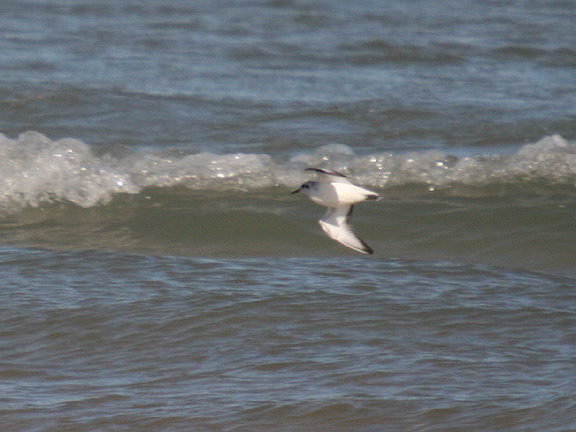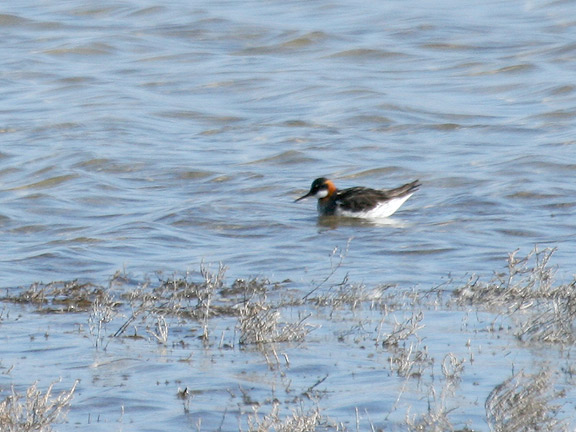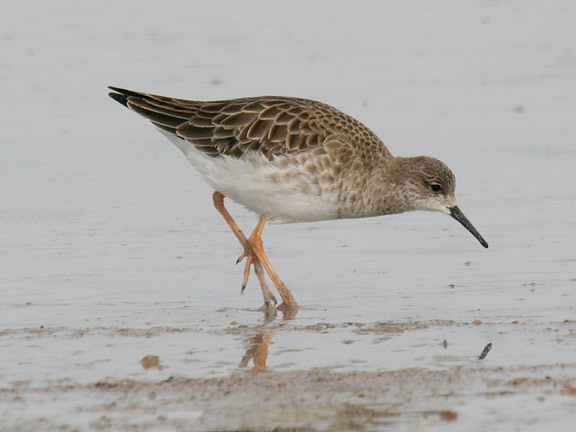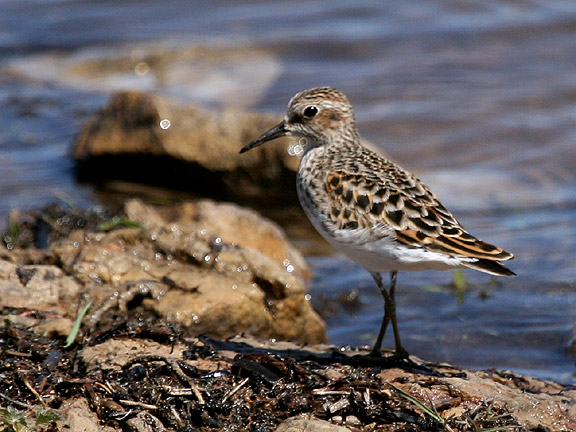That is not to say that shorebirds don’t overwinter around and on the Greats Salt Lake. Killdeer can be found year round on the lake, or in surrounding areas. This was all brought to mind by tow recent sightings that got me thinking about wintering shorebirds up north. About 2 weeks ago there was an American Avocet seen at Saltair, and then this week a Dunlin was reported. I think most winters Avocets are reported, but the Dunlin was surely a great sighting. I decided to do a little digging and see what I could find.
There have been at least 19 species of shorebirds recorded on or around the Great Salt Lake between the months of December and February. Not bad huh? Of course some of these are few or single records; however there are quite a few regularly occurring species.
 Red Phalarope. Copyright Tim Avery
Red Phalarope. Copyright Tim AveryRed Phalarope is the rarest of the recorded winter species. They are a late passage migrant usually coming through Utah between late October and early December. Most records falling November, but there is one report from the causeway on December 3, 1994. The causeway is the ideal location to find this species—either on the rocks or out in the water by the bridge nearest the island. Great Salt Lake State Park is also a great place to look due to the jetties and open water. There have also been overwintering records of Wilson’s Phalarope along the causeway, and a Red-necked Phalarope on the south shore from late November which curiously was a female in full breeding plumage. There is also a single record for Willet from late December at Farmington Bay, although I am not sure it was documented.
 Red-necked Phalarope. Copyright Tim Avery
Red-necked Phalarope. Copyright Tim AveryRuff might actually be more common than a number of the migrants that end up overwintering on the lake. There are at least 3 different winter records for the species along the lake, with 2 coming from the causeway and the other form Farmington Bay. This species prefers tidal flats with shallow pools, so it usually will be along sandy shores or in shallow pools. Overall it is one of the rarest shorebirds recorded in Utah.
 Ruff. Copyright Tim Avery
Ruff. Copyright Tim AveryFrom time to time Sanderling show up on the causeway in the middle of January. This one is quite odd, and ranks up there with Baird’s Sandpiper which has several random sightings along the causeway from each winter month over the years. There have also been a report or two of Western Sandpiper—again from the causeway that are just as mind boggling.
Both Snowy and Black-bellied Plover have been reported in mid winter—from the causeway again. Along with some of the above sightings, these birds bring up the point of sick and injured individuals that may not be able to head south leaving them to deal with the freezing temps and predators. It’s neat to see these birds in mid-winter, but the sad reality may be they are only here because they couldn’t leave.
We have covered most of the one-offs, leaving those birds that are reported more often. Dunlin is probably the rarest, but like the Red Phalarope it also has a migration that extends into November, lending to a couple of December records. Marbled Godwit are a bit of an oddity in that despite migrating heavily in September and October, some linger into November with a few stragglers still being seen in December from time to time. Most of these reports come from Bear River MBR on the north shore of the lake—the outlier from the causeway reports.
This leaves both species of Yellowlegs, Least Sandpiper, Wilson’s Snipe, American Avocet, and Killdeer. All of these species are usually recorded annually either at the lake or in nearby marshes or lakes. Aside from Killdeer which is the most common, and Wilson’s Snipe which is always reported from locations with open water and some type of cover, Avocet is the least likely to be seen. The yellowlegs are usually reported form freshwater marshes, and other open bodies of water on a pretty regular basis making them one of the most likely to be seen candidates. Last but not least is the Least Sandpiper which overwinters at a number of locations in small numbers. Seen singularly or in small groups, this tiny yellow-legged wader will be found anywhere that open-water and food persists—mainly along the causeway.
This is not a scientific analysis of the wintering shorebirds, just an overview. Now it’s up to you to go out and find some!
Labels: Antelope Island, great salt lake, shorebirds, southshore


5 Comments:
I'll do my darndest to find some!
Speaking of winter shorebirds . . . At the Logan Fisheries Experiment Station ("Logan Fish Hatchery") there is a pond that is fed by a warm spring and keeps open water year-round. It is a magnet for winter shorebirds, and right now you can stand in one spot and see upwards of 20 Wilson's Snipe (on Sunday I counted 22), plus usually 1-5 Killdeer. In previous winters the same spot has harbored a Greater Yellowlegs, and even a Short-billed Dowitcher was found there one winter.
We have 2 kildeer that have been using the small amount of water left in the bottom of the reflection pools at UVU for the past month or so. Fun to see a bird I normally associate with summer birding.
Nice Ruff photo.
I see a few Leasts every winter at Farmington Bay, when and where was yours taken? Another nice photo.
Jerry
I totally forgot to add in Long-billed Dowitcher which is also a fairly uncommon species that over winters. Again usually found near freshwater, Decker Lake and Farmington Bay are where they are often found.
Jerry, Thanks! The Least was actually photo's up on Kolob Reservoir in the fall of 2007 I think. I would have to go look to be more sure of the date.
Post a Comment
Subscribe to Post Comments [Atom]
<< Back to Previous